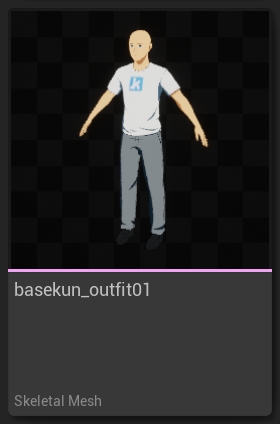Basic Assets - Introduction
This is an introduction to the basic asset types relevant to character models in Unreal.
This page describes them in broad strokes, and individual pages for each provide more specific details.
Skeletal Mesh

When you import your model FBX file, it will appear in Unreal as a skeletal mesh.
This asset contains the mesh itself, but also acts as a central hub that associates other assets to the mesh. Because of this, a skeletal mesh is often the first object that is referenced in Blueprints or code when manipulating the visuals of your character.
For example, when you have a reference to a skeletal mesh in Blueprint, you can play animations on it, change its materials, toggle physics on it, etc.
You Don’t Need Fancy Features
Epic has a habit of shouting their brand-new experimental features from the rooftops and telling you that you need them.
Are there teams in the industry using highly complex stuff like motion matching to produce awesome characters? Yes, and that’s great! But that’s not the norm. There are even more teams using basic techniques (with great assets) to produce awesome characters.
When you’re starting, keep it simple. You’ll find beauty in the basics, and later on you (might) branch out to the fancy stuff.
Remember the Fundamentals
A good character model is a magic trick. We create the illusion of a living breathing character on the screen. But behind the curtain, the ingredients are simple.
I would argue that the fundamentals of this illusion are:
- good art direction
- good deformation
- good animations
Fundamentals Don’t Change

The thing about fundamentals is that they are timeless.
Whether we look at Resident Evil 4 in 2005 or 2023, Leon is a successful character. Great model, and great motion-captured performances. In 2023 the rendering techniques are newer, but he shines in both games.
It doesn’t really matter than Leon’s 2005 model has shadows painted into the textures, and his 2023 model simulates subsurface scattering. He looks great because Capcom knows their fundamentals.
Fundamentals Overshadow Technical Fidelity

Even without fancy bells and whistles, we can still make a world-class game with the bare essentials.
Persona 5 Royal’s character models are dead-simple. But simple does not mean bad; Atlas’ artists produced characters that move well, hit strong poses, and tell a story. Atlas knows their fundamentals.
Practice the Fundamentals
The takeaway here is that you will succeed with good fundamentals, and fail with bad fundamentals. Crucially: no amount of cutting-edge features will save bad fundamentals.
Getting good at art fundamentals takes time and practice. You will spend your entire career getting better at building good meshes and placing bones properly.
A Character Pipeline
It follows that we need a character pipeline that enable us to execute on the things that matter most.
A strong character pipeline allows you to iterate and practice the fundamentals, and is flexible enough to accomodate high fidelity and new features.
This compendium’s goal is to help you make that pipeline, and equip you with the knowledge to build off of it in the future.